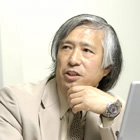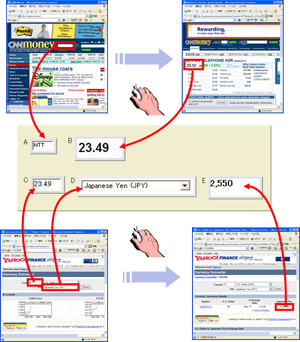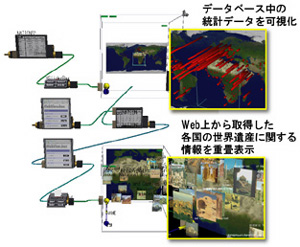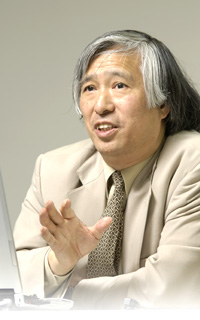Realization of pervasive computing based on knowledge-media technology

Yuzuru Tanaka, Doctor of Engineering,
Director of Meme Media Laboratory,
Professor of the Graduate School of Information Science and Technology, Hokkaido University,
Division of Computer Science's Research Group of Knowledge Software Science
A ubiquitous knowledge environment with the omnipresence of a variety of information and intellectual property
You have been studying knowledge media since the 1980s. What do you think is the current state of the information society surrounding us?
Dr. Tanaka: With the spread of various information devices and media, the speed and volume of information collected, processed and transmitted using information technology are further increasing. A variety of data, tools, multimedia content and services exist on the Web, and are used via wired or wireless networks. While "ubiquitous" means "omnipresent," it is expected that the omnipresence not only of information devices, networks and other types of hardware, but also of various types of knowledge (memes) (Ex. 1) generated and distributed by such hardware will be found in future society. We call this a ubiquitous knowledge environment.
There is, however, one problem. The technology to find what we really need from among the countless data, services and tools on the Web, combine them freely and create new knowledge from them has not yet been established. Although modern society is said to be highly information-oriented, the range of information available is actually limited depending on the models of information terminals and the types and versions of applications. Even though there are all different kinds of memes, these are just things that are given to us. Our laboratory has been addressing this problem since the 1980s, and has conducted research on knowledge media to perform flexible review and redistribution of memes existing on the Web.
Are you referring to the Intelligent Pad (IP) invented in 1987?
Dr. Tanaka: Yes, IP is a system that can easily synthesize applications, Web services and browser functions without rewriting programs. It does this by simply synthesizing and editing existing data and programs as if cutting and pasting them on a piece of paper (pad) (Fig. 1). With the Intelligent Box (IB), which is a three-dimensional extension of IP, even people without programming experience can easily construct three-dimensional software by synthesizing a box of three-dimensional objects in the same way as a pad.

By cutting a window displaying the name of a company and its stock price from a site providing stock information in the United States and a calculation function to convert US dollars into Japanese yen from another site and putting them on one pad, it is possible to display the current stock price of the company in Japanese yen by just entering the company name.
A characteristic of IB is the function to visualize data accumulated in a database in an interactive manner. For example, it can synthesize the World Heritage map on the UNESCO Website and each nation's per capita GDP from another site, and render it as a three-dimensional image (Fig. 2). It is also possible to collect necessary information from multiple databases and related information sites on the web and visualize it by establishing a system on the spot. Physical phenomena that are not visible or tangible can be simulated interactively in a virtual environment. The use of such technology is expected in the field of bioinformatics. A "piazza" (Ex. 2), which pools synthetic pads and boxes on the web for free exchange and trade through the Internet, is also being established.

Information on World Heritage presented on the UNESCO Website and the per capita GDP available on the local database are combined and synthesized/visualized in one table.
Development of a federation architecture that can freely connect knowledge and functions
While IP and IB have already been established as technologies, what do you think about their possible future development?
Dr. Tanaka: The initial purpose of IP and IB was for use as meme media. However, with an era of ubiquity close at hand, there are now demands for a federation of knowledge at a higher dimension rather than just revision and redistribution. The term "federation" here refers to the possibility of combining things at hand on the spot and making them ready to use. This means dynamic changes not only in the information itself but also in the network configuration of omnipresent information devices, and the IP and IB architectures can fully meet such needs. One system we developed, for example, recognizes a user with a PC equipped with a wireless LAN card when he/she enters the room. When the user accesses the piazza from the PC, he/she can automatically jump to the Web page where available services are registered. By copying and opening the proxy of a slide show from the Web page, the slide presentation service can be received as a pad. The user can just drag and drop PC data to the pad to prepare a slide show presentation.
Even if we bring our own PC to a venue, we may not be able to use it if its connection does not match the system installed at the venue. But if we use IP, it is possible to create a connection-free environment on the spot, isn't it?
Dr. Tanaka: Besides PCs, we use a variety of information devices, including PDAs, mobile phones, embedded computers and servers. Ultra-micro computers with integrated sensors, processing and communication features (such as smart chips and smart dust) will also become popular in the future. If computers can be miniaturized, it will be possible to establish a network by embedding them into walls, floors, desks, documents and various other things. I currently serve as the leader of the 21st Century COE Program called the Meme-Media Technology Approach to the R&D of Next-Generation Information. In the program, research and development of software technology to achieve a ubiquitous knowledge environment (including ultra-micro computers and the immediate formation of a federation) are being promoted through cooperation among the three fields of knowledge media, quantum integration electronics and intelligent communication.

Human evolution through tools to aid thinking
Connecting various types of knowledge and services that were not originally designed to be connected, easily and on the spot, seems to be exactly the way the ubiquitous era should be. What kind of vision is being created in the background of such research and development?

Dr. Tanaka: What I focus on is a world where our ideas can be turned into reality on the spot. With current computers, even if you think, "I want to experiment with something new by combining this and this," you cannot do it immediately. Since you have to improve programs or develop new applications, it takes a certain amount of time and energy. Both your experiment and your thinking must stop until the new software is complete. We intend to realize an environment where the stopping of the thought process can be minimized, where a tool can be created while thinking, and where something new can be tried immediately using the tool and another new hypothesis can be generated from there.
In a ubiquitous knowledge environment, diverse types of computers will be integrated not only into the web but also into the environment itself, including home electrical appliances, roads and buildings, and will constantly provide services in certain ways. Such a situation is called "pervasive computing." I aim to realize pervasive computing by which ordinary people will have access to flexible federations.
If it becomes possible for people who are not computer specialists to create new software programs and applications easily, what effect will this have on society?
Dr. Tanaka: We will be able to turn ideas into reality the moment we come up with them or create new environments at the same speed as we think, and more new ideas will be born from there. I can say that this is a completely new tool that is a first for mankind. If tools for thinking evolve and it becomes possible to materialize our ideas at the same speed as we think, forms of information and intellectual property created from there should be completely new and different from the past. My own ideas have changed dramatically since I began to work using IP and IB. New tools may change people's thinking itself. This is truly the beginning of an era of new evolution for mankind.
Explanation
Explanation 1: Meme
A meme represents a "cultural gene," and is seen as the knowledge and culture of mankind that evolves and is inherited while going through a process of self-replication, natural selection and mutation like the genes of living things. While the advance of computers and media gives end users the freedom to edit various types of multimedia information, more importance has recently been placed on prompt distribution and exchange (not only for multimedia information but also for various tools and large amounts of experience data) in an interdisciplinary and international manner. In Professor Tanaka's laboratory, research is conducted on meme media and meme market architectures that facilitate the review and redistribution of memes accumulated on the web.
Explanation 2: Piazza
A piazza is equivalent to a bazaar or a market that provides a place to exchange and trade pads and boxes. Spaces to open markets can be established on the Internet, and everyone can freely exhibit tools and documents in each space. Users can access the space in accordance with their needs, and can import objects exhibited there into their own environment in pad format. Professor Tanaka's laboratory named such spaces piazzas and conducted research and development of their architecture.
